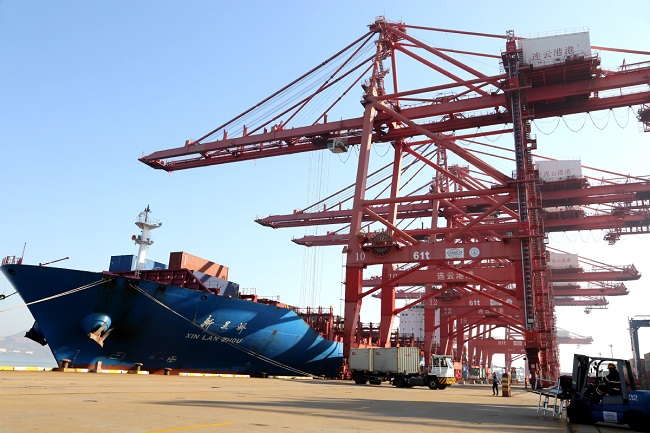
A cargo vessel is loaded at Lianyungang Port, Jiangsu province. [Photo by Wang Chun/For China Daily]
As Gulf countries place greater emphasis on the urgent need to diversify their economic sustainably, the influence of China's robust economic and technological advances as well as the Belt and Road Initiative increases, experts say.
Furkan Halit Yolcu, a research assistant at Sakarya University Middle East Institute in Turkey, said China is "an active investor with fewer demands in terms of dependency".
The West, he said, requires a certain level of alignment "if it is going to invest in your country", and Chinese investment comes with "less political luggage".
"Middle Eastern nations are becoming more and more aware that the financial ease they have had over the last 40 years is losing its leverage. The region has to discover new ways of growth and provide sustainable solutions to avoid succumbing to financial instability and lack of decentralization."
Patrick Cooke, managing editor for the Middle East and Asia with the research and advisory company Oxford Business Group, said Middle East investment in China and elsewhere in emerging Asia is a growing trend, accompanied by increasing trade between the two regions.
Such investment is being driven by the need for Middle Eastern economies to diversify, and is led, in part, by the large sovereign wealth fund of the Gulf Cooperation Council countries seeking long-term returns beyond their home markets, he said.
The council is a political and economic bloc comprising Bahrain, Saudi Arabia, Oman, Qatar, Kuwait and the United Arab Emirates.
"At the same time, China has been channeling large amounts of investment into strategic projects in GCC countries," Cooke said. "This is occurring not just in hard infrastructure but in areas such as information and communications technology, healthcare and green tech, as Gulf countries seek Asian expertise to accelerate the digital transformation process."
In terms of infrastructure, China has signed documents with 19 countries in the Middle East for collaboration as part of the Belt and Road Initiative. Its main imports from the region are energy resources, most of which come from Saudi Arabia, Oman, Kuwait and the UAE.
According to a recent study titled "China Position 2021: Sustaining institutional interest" by Economist Impact, sponsored by the investment management firm Invesco, 44 percent of Middle East senior investment professionals said their China exposure had risen over the past 12 months.
Despite the challenges brought by the pandemic, at least 77 percent spoke of plans to further increase exposure over the coming 12 months, and 74 percent said they expected better economic conditions in China than elsewhere over the year.
Farhan Mujahid Chak, an associate professor of political science in Gulf Studies at Qatar University, said the BRI is a "brilliant initiative that is a win-win for China and participating developing economies".
Relations between China and the GCC reached a milestone when two-way trade between the two sides reached $160 billion last year, making China the largest trading partner for the bloc and its biggest export market for petrochemicals.
Middle Eastern leaders value stability the most over other "components of political success", Yolcu said. As such, they do not want to be fully dependent on a single source of political and financial stability. China, in this regard, "comes forward in this endeavor to amplify the sources of legitimization, stability and investment".